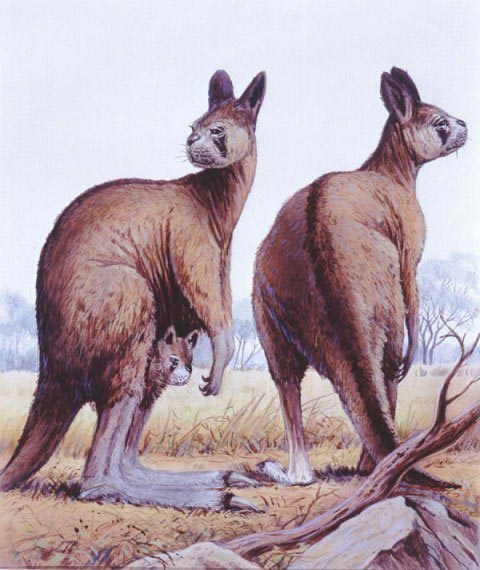The prehistoric people once genocated large mammals
According to Bristol University research, prehistoric people were the cause of massacres of massive kangaroo and giant koalas as well as rhinos in a very short time. They wiped out large animals in the period of 40,000 to 50,000 years ago.

Giant prehistoric Kangaroo.
Dr. Alistair, Department of Archeology and Anthropology, Bristol University, together with Australian National University colleagues (ANU) in Canberra analyze 60 large-sized bones and teeth excavated in Cuddie Springs, New South Wales .
Cuddie Springs has become the center of a debate about the era and the extinction cause of the giant kangguru in the region between Australia, where it finds remains of prehistoric humans and animal bones in sediments. These classes are defined as dating from 30,000 to 40,000 years ago. Particularly, animal skeletons have not been able to conclude about the existence period.
ANU researchers headed by Rainer Grün analyzed the bones and teeth of large animals at Cuddie Springs using their atoms marked with uranium and electronic magnetic resonance methods to date and conclude. animals extinct for at least 50,000 years.
That said, there is a simultaneous existence between prehistoric humans and giant animals, which are hunted by humans to the point of extinction when the first humans settled in the continent.
Dr. Pike said: 'The reason for the disappearance of large mammals in Australia, Europe and North America is a hotly debated issue. Some people believe that it is due to the climate change of the Ice Age, but most of the comments state the cause of excessive human hunting. '
'To understand which ideas are more plausible, we have developed a method of dating the skeletons by the radioactive degradation of the small amount of residual uranium contained in fossils. This method is particularly useful for places like Cuddie Springs, where old and new relics are mixed together due to erosion. On that basis we affirm the second hypothesis'.
- Giant prehistoric beasts
- 200 years later, the largest terrestrial mammal could be cattle
- Great extinct Australian mammals
- Prehistoric beavers used to dominate the world after the dinosaur era
- Prehistoric fish have teeth like humans
- Footprints of 3.6 million years of prehistoric people reveal many secrets
- Deciphering the incredible life of prehistoric people
- Life is equally amazing between modern people and prehistoric people
- Prehistoric people used to eat the dead relatives
- The relics in the volcanic cave have bones of prehistoric people in Dak Nong
- Prehistoric people painted animals more beautiful than modern people
- Archaeological discovery of venomous mammals on hind legs
 Discovered an ancient centipede fossil 99 million years old
Discovered an ancient centipede fossil 99 million years old Discovered bat-like dinosaurs in China
Discovered bat-like dinosaurs in China Discovered a 200-year-old bronze cannon of the coast
Discovered a 200-year-old bronze cannon of the coast Discover 305 million-year-old spider fossils
Discover 305 million-year-old spider fossils